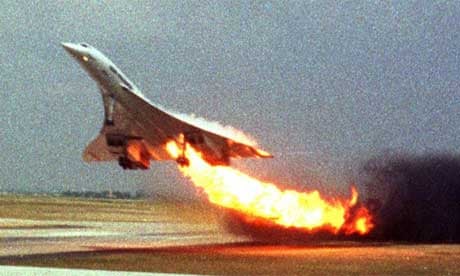Witness reports have cast doubt on the official account into the Concorde crash that killed 113 people, according to lawyers for Continental Airlines, the US carrier accused of causing the accident.
Continental Airlines is to be tried with five other defendants in France on 2 February. A lawyer for the airline says evidence from 28 witnesses, including firefighters and pilots, invalidates the accepted cause of the crash in 2000.
The evidence will be featured in a TV documentary to be shown on the French channel Canal+ tonight.
The French air investigation agency concluded that the accident was caused by Concorde hitting a 43.5cm (17-inch) strip of titanium from a Continental Airlines plane that had taken off minutes earlier from Charles de Gaulle airport.
This set off a catastrophic chain of events as pieces of rubber hit an engine causing the fuel tank to rupture and leak kerosene, which then caught fire, it reported.
Concorde was seen roaring down the runway with a plume of flames from its tail. Having passed the point of no return, the Concorde pilot was forced to carry on but crashed two minutes later on to a hotel in the town of Gonesse just outside the French capital.
Of the 113 dead, 100 were passengers, most of them German, nine were crew, and four were workers at the hotel.
Olivier Metzner, Continental's French lawyer, said the new witness accounts painted a different scenario, calling into question the safety and maintenance of Concorde.
"We will show the court that the fire that caused the crash happened before Concorde and the piece of metal came in contact," he said.
He added: "At that time Concorde was not in a sufficiently safe state to fly and that had been the case for some years."
A judicial source told Reuters that the witnesses had already been questioned and their testimony rejected during the long investigation leading up to the trial.
The new information includes allegations the plane was overloaded by a tonne and a half, was missing part of its wheel mechanism that held the two front wheels parallel, and was already on fire by the time it hit the strip of metal.
Metzner is suggesting the tyre may have burst because of a bump or fault in the runway.
It is also claimed there had been 67 accident reports involving Concorde tyres between 1979 and 2000, seven of which included a rupture of the fuel reservoirs under the plane's wings. It is alleged there were no modifications made to the plane until 2001.
The new theories have been entirely denied by Air France. The lawyer for Air France, which is not facing legal action, has denied the missing wheel part had any link with the accident.
After the crash Air France halted all Concorde flights. The last British Airways Concorde flew its final commercial flight on 24 October 2003.
